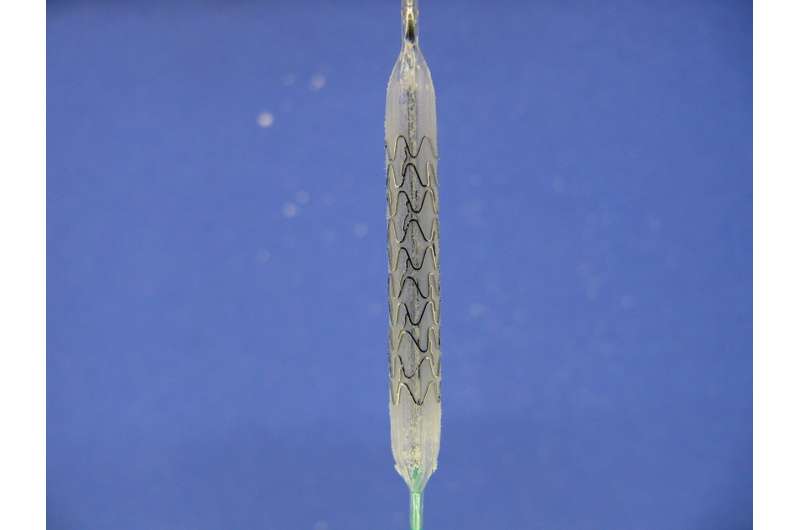Battling myocardial infarction with drug-coated balloon catheters

In Germany, nearly 6 million people suffer from coronary heart disease. The disease is caused by calcium deposits which constrict the coronary arteries. Doctors generally use a stent to widen the narrow pathway. However, the blood vessel often constricts further, thus necessitating further interventions. For this reason, a drug-coated balloon catheter inserted in minimally invasive cardiac surgery is increasingly serving as a replacement for the risky stent treatment. In current practice, the balloons are often coated manually. A new device is intended to automate this time-consuming procedure. Along with partner companies, a team from the Fraunhofer Institute for Production Systems and Design Technology IPK is developing a prototype of such a device.
Shortness of breath and acute chest pain can be signs of coronary heart disease (CHD). If left untreated, this can lead to severe consequences, including myocardial infarction. Caused by calcium deposits on the inner linings of the arteries, CHD is a leading cause of death among adults. This build-up causes blockage in the veins, and the heart no longer receives a sufficient supply of oxygen.
Doctors thus widen the constricted pathways to allow the blood to once more have unrestricted flow. To achieve this, they insert a balloon catheter with a plastic support, i.e. a "stent," into the constricted artery. When the balloon catheter is inflated, the stent expands, thus expanding the stenosis. The problem is that over the course of a few months, the tissue around the stent can grow back into the blood vessel. This leads to further constriction called restenosis. This risk has increasingly led doctors to favor an alternative procedure whereby no foreign objects are left in the damaged arteries: balloon catheters coated with immunosuppressors and cytostatic drugs are expanded and cause the vessel to dilate mechanically. The active substances that are thus injected into the vessel can inhibit restenosis, i.e. the increased growth of the tissue cells due to the mechanical stress, keeping the vessel from closing back up. The substances are conveyed via the surface of the balloon directly onto and into the artery walls.
At present, the coating of the catheters with drugs—especially with particularly advanced ones—is often performed manually by skilled workers. This process is time consuming and error prone. The procedure is very specific, and specialists with appropriate expertise are few and far between.
Process security via automation
For this reason, a team at Fraunhofer IPK is researching how the laborious process of coating balloon catheters could be automated. In the joint project "Heliko—Automated and process-safe coating of balloon catheters with active substances" funded by the German Federal Ministry of Education and Research (BMBF), an automated coating machine prototype is being developed. The scientists are closely cooperating with InnoRa GmbH, a spin-off of Berlin's Charité, and Organical CAD/CAM GmbH. InnoRa has developed and patented numerous coating procedures, Organical is developing the machine system for the automated coating system in order to enable serial production of the balloon catheters. The objective of the project is to reduce the reject rate, significantly increase the sales volume of balloons and guarantee process safety.
This is no trivial task, as the microscopic crystals of the medication ideally need to point outward in the same direction. This is the only way that the active substance can penetrate the cell walls quickly and effectively. The thickness of the coating and the composition of the coating surface play key roles in the success of the process. "The balloon catheters must convey the medication immediately into the artery wall. This process must not take any longer than one minute in order to keep the heart's supply of oxygen from being interrupted for too much time. For this reason, the surface may not be too smooth: a vectored conformation of the crystals ensures more optimal transfer of the active substance," says Gregor Dürre, researcher at Fraunhofer IPK. At the same time, the desired structure of the crystals results in the medication having a prolonged effect in the artery wall. Once the drug has been released, the balloon catheter is deflated and then removed.
Fragile membrane—difficult coating process
Numerous factors such as kinematics, amount of pressure applied, coating speed, coating duration and speed of rotation impact the crystal structure and thus the construction of the automatic coating machine. "The catheter balloon is a fragile and exceptionally thin membrane that needs to be coated in its expanded state. That is incredibly difficult. The slightest of mistakes can lead to tears in the membranes that are only 20–80 micrometers thick," says Annika Brehmer, biotechnology specialist and colleague of Gregor Dürre. The construction of the coating unit is equally challenging, a task with which the Fraunhofer IPK has been charged.
In order to achieve the desired conformation for the crystallization of the solution on the balloon membrane, the crystallization conditions must be precisely controlled during the coating process. For this purpose, there are two motors which rotate the filament on which the balloon is stretched to ensure that it is evenly coated. The coating head is positioned in relation to the balloon membrane. The coating process then takes place in sequential fashion with the balloon rotating and the coating head simultaneously being shifted from one strip to another. An integrated, high-resolution optical surface measurement device takes over for the quality control by constantly measuring the coating thickness. The coating procedure typically takes between three to five minutes.
The throughput can be drastically increased in comparison to the manual procedure—not to mention the added benefits of process safety and the quality control with the measuring device. Researchers are currently working on optimizing the prototype. At a later point in time, the effectiveness of the balloons will be tested in in vivo studies. The automated coating machine should be market-ready in early 2023.


















